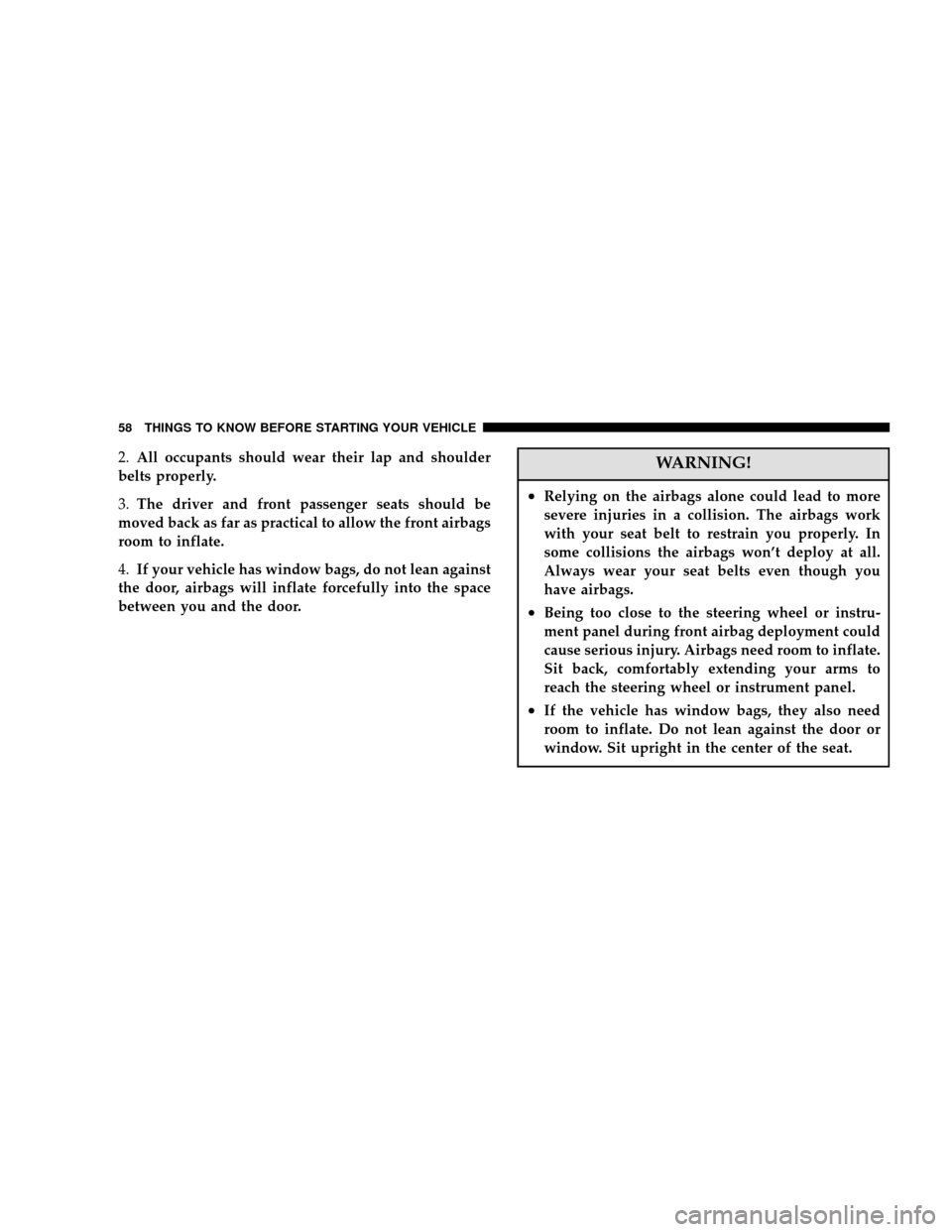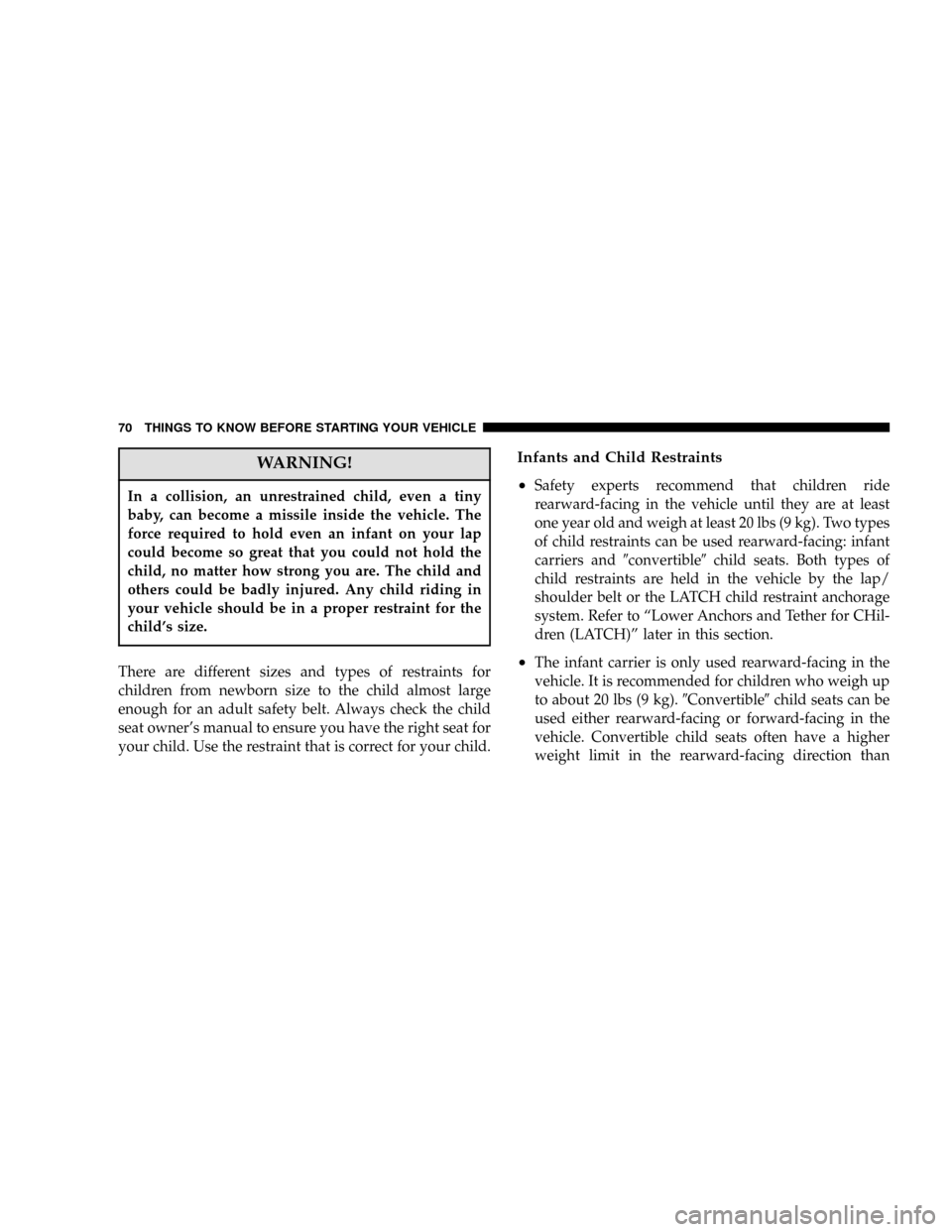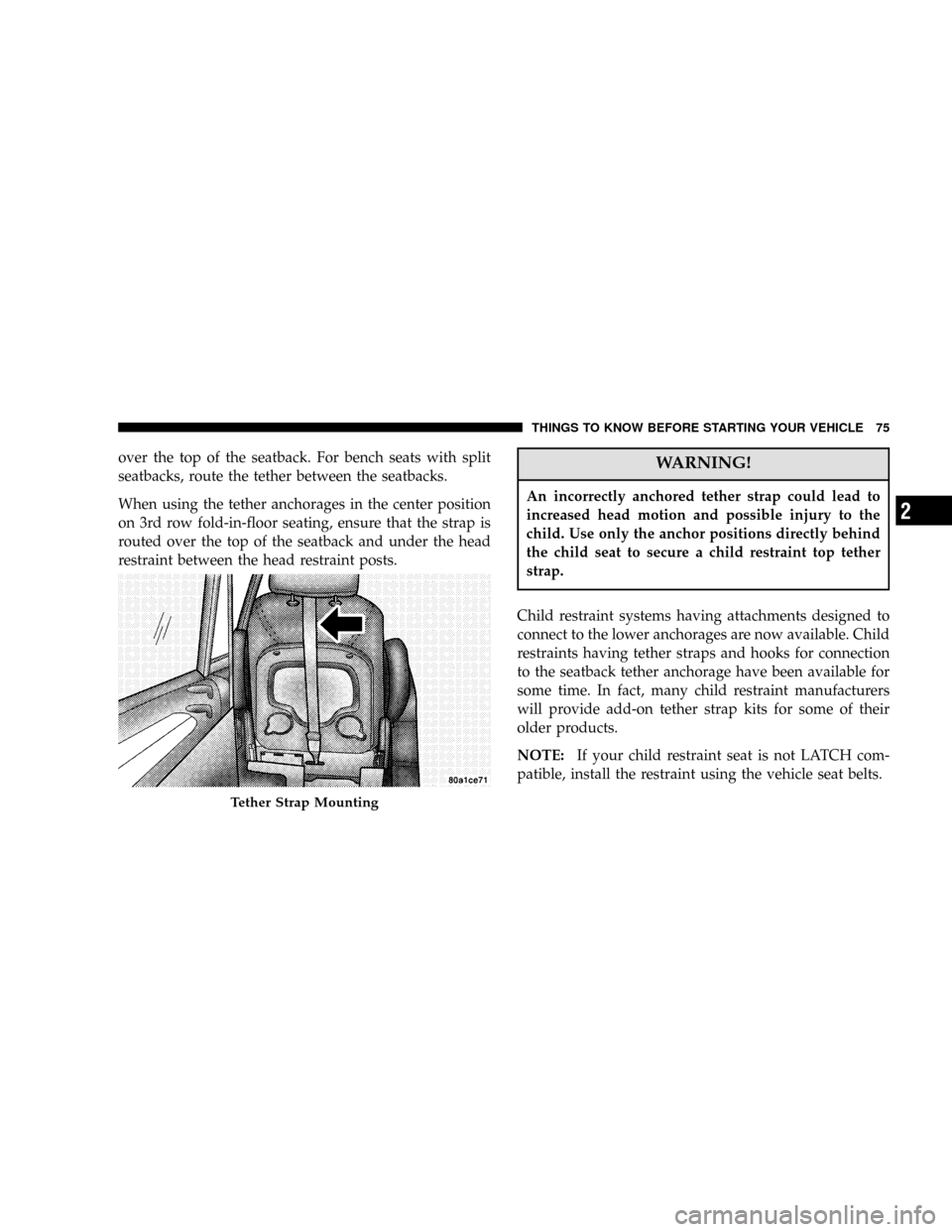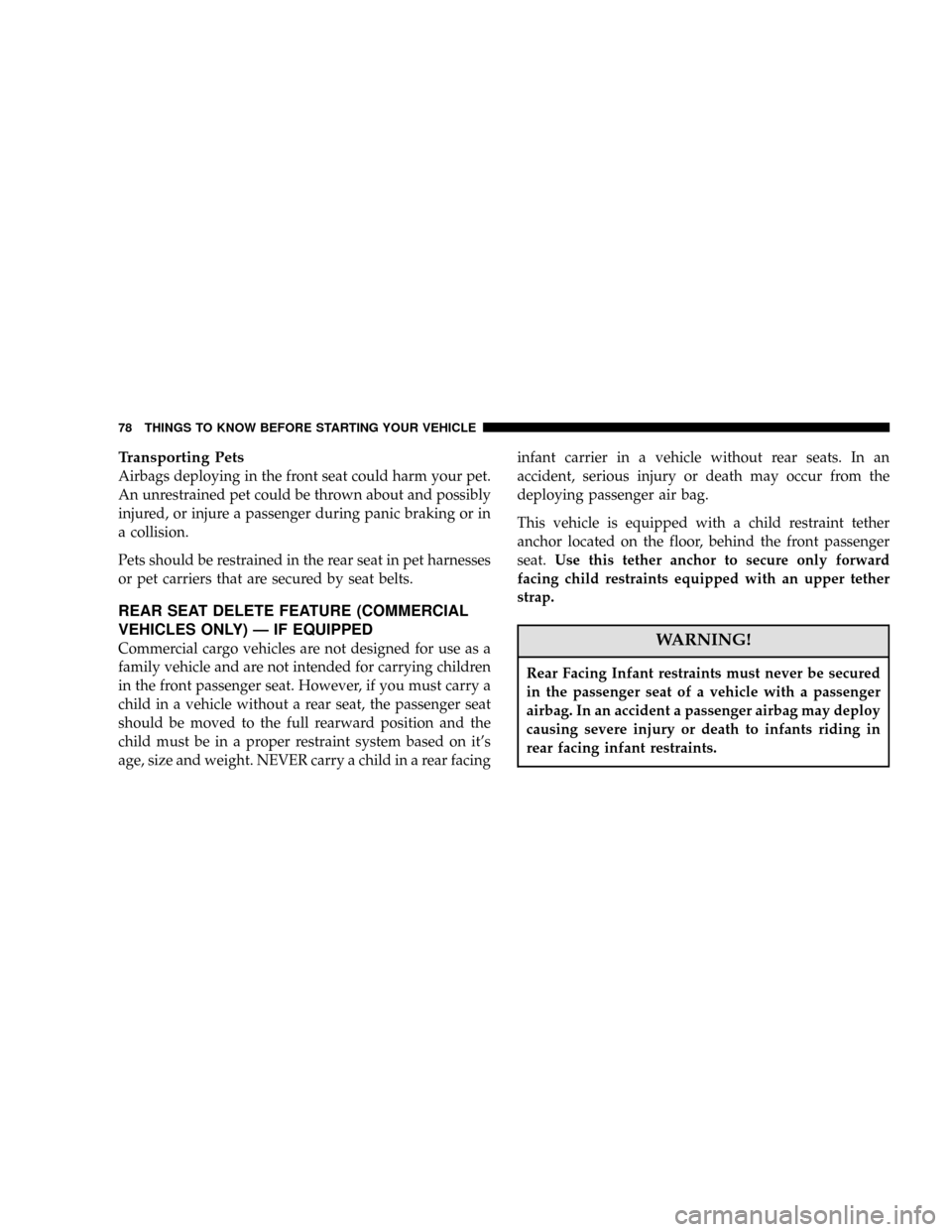Page 58 of 504

2.All occupants should wear their lap and shoulder
belts properly.
3.The driver and front passenger seats should be
moved back as far as practical to allow the front airbags
room to inflate.
4.If your vehicle has window bags, do not lean against
the door, airbags will inflate forcefully into the space
between you and the door.WARNING!
•Relying on the airbags alone could lead to more
severe injuries in a collision. The airbags work
with your seat belt to restrain you properly. In
some collisions the airbags won’t deploy at all.
Always wear your seat belts even though you
have airbags.
•Being too close to the steering wheel or instru-
ment panel during front airbag deployment could
cause serious injury. Airbags need room to inflate.
Sit back, comfortably extending your arms to
reach the steering wheel or instrument panel.
•If the vehicle has window bags, they also need
room to inflate. Do not lean against the door or
window. Sit upright in the center of the seat.
58 THINGS TO KNOW BEFORE STARTING YOUR VEHICLE
Page 69 of 504

•The light remains on or flickers after the 6 to 8 second
interval.
•The light flickers or comes on and remains on while
driving.
DaimlerChrysler Corporation Integrated Child
Seat—If Equipped
Operating instructions for this seat are included with the
seat. If the instructions are not with the seat or in the
Owner’s Manual Package, replacement instructions can
be obtained.
To obtain Integrated Child Seat replacement
instructions:
Use the order form at the back of this manual and specify
publication number 81-016-1950.
Child Restraint
Everyone in your vehicle needs to be buckled up at all
times—babies and children, too. Every state in the
United States and all Canadian provinces require that
small children ride in proper restraint systems. This is the
law, and you can be prosecuted for ignoring it.
Children 12 years and under should ride properly buck-
led up in a rear seat. According to crash statistics,
children are safer when properly restrained in the rear
seats, rather than in the front.
THINGS TO KNOW BEFORE STARTING YOUR VEHICLE 69
2
Page 70 of 504

WARNING!
In a collision, an unrestrained child, even a tiny
baby, can become a missile inside the vehicle. The
force required to hold even an infant on your lap
could become so great that you could not hold the
child, no matter how strong you are. The child and
others could be badly injured. Any child riding in
your vehicle should be in a proper restraint for the
child’s size.
There are different sizes and types of restraints for
children from newborn size to the child almost large
enough for an adult safety belt. Always check the child
seat owner’s manual to ensure you have the right seat for
your child. Use the restraint that is correct for your child.
Infants and Child Restraints
•
Safety experts recommend that children ride
rearward-facing in the vehicle until they are at least
one year old and weigh at least 20 lbs (9 kg). Two types
of child restraints can be used rearward-facing: infant
carriers and�convertible�child seats. Both types of
child restraints are held in the vehicle by the lap/
shoulder belt or the LATCH child restraint anchorage
system. Refer to“Lower Anchors and Tether for CHil-
dren (LATCH)”later in this section.
•The infant carrier is only used rearward-facing in the
vehicle. It is recommended for children who weigh up
to about 20 lbs (9 kg).�Convertible�child seats can be
used either rearward-facing or forward-facing in the
vehicle. Convertible child seats often have a higher
weight limit in the rearward-facing direction than
70 THINGS TO KNOW BEFORE STARTING YOUR VEHICLE
Page 71 of 504

infant carriers do, so they can be used rearward-facing
by children who weigh more than 20 lbs (9 kg) but are
less than one year old.
•Rearward-facing child seats mustNEVERbe used in
the front seat of a vehicle with a front passenger
airbag. An airbag deployment could cause severe
injury or death to infants in this position.
Older Children and Child Restraints
•Children who weigh more than 20 lbs (9 kg) and who
are older than one year can ride forward-facing in the
vehicle. Forward-facing child seats and convertible
child seats used in the forward-facing direction are for
children who weigh 20 to 40 lbs (9 to 18 kg) and who
are older than one year. These child seats are also held
in the vehicle by the lap/shoulder belt or the LATCH
child restraint anchorage system. Refer to“Lower
Anchors and Tether for CHildren (LATCH)”later in
this section.
•The belt-positioning booster seat is for children weigh-
ing more than 40 lbs (18 kg), but who are still too small
to fit the vehicle’s seat belts properly. If the child can
not sit with knees bent over the vehicles seat cushion
while the child’s back is against the seat back, they
should use a belt-positioning booster seat. The child
and booster seat are held in the vehicle by the lap/
shoulder belt.
Children Too Large For Booster Seats
Children who are large enough to wear the shoulder belt
comfortably, and whose legs are long enough to bend
over the front of the seat when their back is against the
seatback, should use the lap/shoulder belt in a rear seat.
•Make sure that the child is upright in the seat.
•The lap portion should be low on the hips and as snug
as possible.
THINGS TO KNOW BEFORE STARTING YOUR VEHICLE 71
2
Page 74 of 504

Don’t leave it loose in the vehicle. In a sudden stop or
collision, it could strike the occupants or seatbacks and
cause serious personal injury.
Lower Anchors and Tether for CHildren (LATCH)
Each vehicle, except commercial cargo vehicles, is
equipped with the child restraint anchorage system
called LATCH, which stands for Lower Anchors and
Tether for CHildren. Two LATCH child restraint anchor-
age systems are installed on all second-row seats and in
the center position on all 3rd row fold-in-floor seats.
Second-row seats also feature tether strap anchorages,
located in the rear surface of the seatback. In addition, all
3-passenger bench seats and 3rd row fold-in-floor seats
are equipped with a child restraint tether anchor at the
center seating position.When using the tether anchorages in the outboard seat-
ing positions, ensure that the strap is routed over the top
of the seatback and under the head restraint between the
head restraint posts. Except for bench seats with split
seatbacks, when the tether anchorage is used in the center
seating position, the strap should be positioned straight
Latch Anchorages
74 THINGS TO KNOW BEFORE STARTING YOUR VEHICLE
Page 75 of 504

over the top of the seatback. For bench seats with split
seatbacks, route the tether between the seatbacks.
When using the tether anchorages in the center position
on 3rd row fold-in-floor seating, ensure that the strap is
routed over the top of the seatback and under the head
restraint between the head restraint posts.WARNING!
An incorrectly anchored tether strap could lead to
increased head motion and possible injury to the
child. Use only the anchor positions directly behind
the child seat to secure a child restraint top tether
strap.
Child restraint systems having attachments designed to
connect to the lower anchorages are now available. Child
restraints having tether straps and hooks for connection
to the seatback tether anchorage have been available for
some time. In fact, many child restraint manufacturers
will provide add-on tether strap kits for some of their
older products.
NOTE:If your child restraint seat is not LATCH com-
patible, install the restraint using the vehicle seat belts.
Tether Strap Mounting
THINGS TO KNOW BEFORE STARTING YOUR VEHICLE 75
2
Page 78 of 504

Transporting Pets
Airbags deploying in the front seat could harm your pet.
An unrestrained pet could be thrown about and possibly
injured, or injure a passenger during panic braking or in
a collision.
Pets should be restrained in the rear seat in pet harnesses
or pet carriers that are secured by seat belts.
REAR SEAT DELETE FEATURE (COMMERCIAL
VEHICLES ONLY)—IF EQUIPPED
Commercial cargo vehicles are not designed for use as a
family vehicle and are not intended for carrying children
in the front passenger seat. However, if you must carry a
child in a vehicle without a rear seat, the passenger seat
should be moved to the full rearward position and the
child must be in a proper restraint system based on it’s
age, size and weight. NEVER carry a child in a rear facinginfant carrier in a vehicle without rear seats. In an
accident, serious injury or death may occur from the
deploying passenger air bag.
This vehicle is equipped with a child restraint tether
anchor located on the floor, behind the front passenger
seat.Use this tether anchor to secure only forward
facing child restraints equipped with an upper tether
strap.WARNING!
Rear Facing Infant restraints must never be secured
in the passenger seat of a vehicle with a passenger
airbag. In an accident a passenger airbag may deploy
causing severe injury or death to infants riding in
rear facing infant restraints.
78 THINGS TO KNOW BEFORE STARTING YOUR VEHICLE
Page 79 of 504

Restraining Infants and Small Children with Seat
Delete Feature (Commercial Vehicles Only)
There are different sizes and types of restraints for
children from newborn size to the child almost large
enough for an adult safety belt. Use the restraint that is
correct for your child:
•The rearward-facing infant carrier is for babies weigh-
ing up to about 20 lbs (9 kg), and less than one year
old. THIS TYPE OF SEAT CANNOT BE USED IN A
VEHICLE EQUIPPED WITH THE REAR SEAT DE-
LETE FEATURE (Commercial Vehicles Only).
•The forward-facing child seat is for children from
about 20 to 40 lbs (9 to 18 kg), and more than one year
old.
•A“convertible”child seat, one that is designed to be
used for children who are too heavy for a rear facing
infant seat, may be used IN THE FORWARD FACING
POSITION ONLY, IT MUST NEVER BE INSTALLED
FACING TO THE REAR IN A VEHICLE EQUIPPED
WITH THE REAR SEAT DELETE FEATURE (Com-
mercial Vehicles Only). When a convertible seat is
properly installed forward facing, the vehicle seat
should be adjusted to therear most position.
•Children more than 40 lbs (18 kg) should be secured in
the passenger seat in a child restraint or belt-
positioning booster seat with the seat adjusted to the
rear most position. Older children who do not use
child restraints or belt-positioning booster seats
should ride properly buckled in the passenger seat
with the seat adjusted to the rear most position. Never
allow children to slide the shoulder belt behind them
or under their arm.
THINGS TO KNOW BEFORE STARTING YOUR VEHICLE 79
2